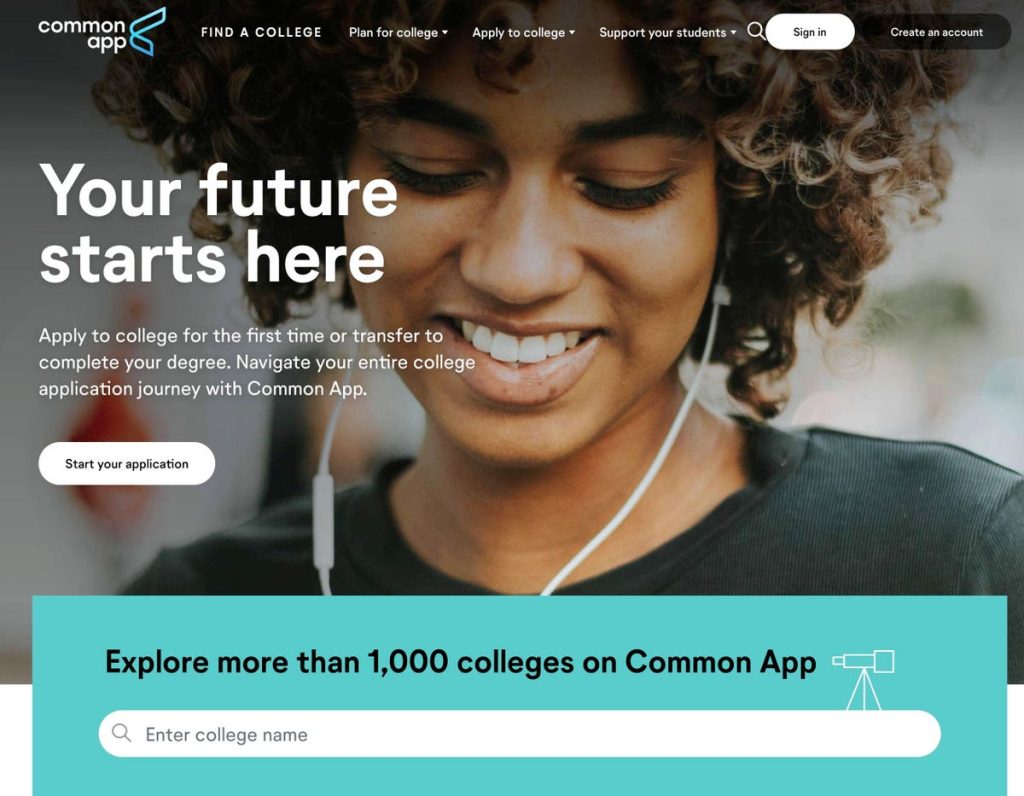The Common App is a shared application system that is used by just under 1,000 colleges and universities in the United States, and roughly 70 international institutions. Last year, the Common App processed more than 7 million college applications from 1.25 million unique students around the world. As acceptance of the Common App has grown, it has increasingly become the default way that students apply to college.
In this post series, I’ll be doing a deep dive into the entire Common App, going section by section to help students and their families gain a deeper understanding of the application. I’ll also share my top tips and tricks for filling out the Common App, and discuss common mistakes and pitfalls to watch out for. Today, I’ll be providing an overview of the account creation process and the basic structure of the Common App. I’ll also share some overarching guidelines and principles for successfully filling it out.
Ultimate Common App Guide – Article Links
- Part 1 – Overview and Account Creation (this post)
- Part 2 – Profile and Family Sections
- Part 3 – Education and Testing Sections
- Part 4 – Activities and Writing Sections
- Part 5 – College Supplements and FAQ
Account Creation
Let’s start by taking a quick look at the account creation process, which begins on the homepage of the Common App. To get started, you’ll need to create an account – head to the top right corner and click on “Create an account.”.
You’ll be presented with various options for account creation, and most prospective college students should opt for the “first year student” account. If you’re an educational professional or a parent creating an account on behalf of a student, ensure you select the appropriate account type. Selecting one of those options will create a “practice account,” which means you can fill out an application, but can’t actually submit it to universities. So if you want to be able to submit an application, you’ll need to select “first year student.”
Once you’ve made your selection, you’ll be directed to the account creation process. It’s relatively straightforward, but you will need to provide detailed contact information, including your email address, phone number, and personal details like your name and date of birth. The information you provide during account creation will auto-fill in your application. This feature can save you time, but if you make an error here, you’ll have to correct it later in your application.
The final part of account creation deals with privacy policies and preferences. First, they’ll ask if you’re based in the European Union, to ensure compliance with GDPR regulations. They also ask two additional questions about your communication preferences, and ask you to agree to the Terms of Use and Privacy Policy.
- Can the Common App can share your contact information with colleges?
- Can the Common App’s communicate with you using the information you’ve provided?
Should you allow the Common App to share your contact details with colleges or contact you directly?
It really comes down to personal choice. Some students find the reminders and communication beneficial, especially if they prompt you to complete a pending task. Others feel like it just invites more unnecessary spam for colleges and extra clutter in your inbox. However, if you appreciate reminders, consider leaving these preferences checked.
These boxes checked by default during account creation, so if you’d rather not receive additional emails from colleges, make sure you consciously uncheck the appropriate boxes. If you change your mind later, these settings can be adjusted within your Common App account, though they’re a bit buried.
An Overview of the Common App
Once you’ve created an account, you’ll be dropped onto the main page of the Common App, which consists of five tabs.
The dashboard is essentially the home page of the Common App – it displays the colleges you’ve added to your list, allows you to remove schools, and summarizes key information about your application to each institution. “My Colleges” is an extension of the dashboard – it once again showcase the colleges you’ve added to your list and provides access to college-specific supplements required by each institution. The “Common App” tab contains the primary application form that is shared across all colleges, and the College Search tab allows you to search for colleges and add them to your list.
The college search feature is pretty easy to use. Say you’re searching for the University of Chicago; just type its name in and the results will pop up.
The platform also has a bunch of filters that you can use to narrow down your search. For example, if you filter down on colleges in Connecticut, the search results will be limited to colleges from that state. One thing worth remembering is that if you enter something in the search bar, then apply a filter which contradicts the search term, it might appear that there are no results. Make sure you either clear out your search bar or add filters that are consistent with your search.
Lastly, the financial aid tab is more or less irrelevant to the application process. The tab contains links to stuff that is relevant like the FAFSA (the actual financial aid application) and some general info about the process of accessing financial aid. The actual financial aid application does not happen on the Common App – it happens elsewhere. You don’t need to spend any time on this tab.
The Structure of the Common App
The core Common Application consists of seven distinct sections:
- Profile: This collects personal details like your address, contact info, demographics, language, geography, nationality, and eligibility for the Common App fee waiver.
- Family: This collects details about your parents, siblings, guardians, and step-parents.
- Education: This collects information about your high school, college courses, grades, awards, community organizations, and future aspirations.
- Testing: This collects self reported information about standardized tests lik the SAT, ACT, AP exams, IB exams, and English language proficiency exams (for international students).
- Activities: This is essentially your resume on the Common App, where you share details about your top 10 extracurricular activities.
- Writing: This is where you’ll submit your personal statement and provide insights on experiences related to the COVID-19 pandemic or any other circumstances that impacted your educational journey.
- Courses & Grades: This section collects detailed information about your coursework from 9th to 12th grade and any additional courses taken outside school. Most colleges do not require detailed self-reporting of courses and grades
5 Overarching Tips for Filling Out the Common App
I want to wrap this article up by sharing a few overarching tips and things to keep in mind while filling out the Common App:
- Question Visibility: One of the nuances of the Common App is that not every question is immediately visible when you start filling it out. For instance, in the Profile section, sharing an alternate first name triggers an additional question. Based on your responses, you may need to fill out extra fields.
- 20 College Cap: The Common App allows you to apply to up to 20 colleges with a single account. If you plan on applying to more than 20 Common App schools, you’ll need to set up a new account with a distinct email address.
- One-time Submission: You only need to fill out the Common Application once. However, once you submit it to a specific college, you cannot modify that submission. Therefore, meticulously double or triple-check everything you’ve entered before clicking submit.
- Minimize Unnecessary Information: My philosophy with the Common App is to offer as little extra information as you can. If something isn’t essential for understanding your background or journey or likely to boost your application, it’s best left out. There are two reasons why. First, each piece of information you share is one more item that must be double and triple checked. Second, extra information can introduce uncertainty about how an admissions officer might react. If an extra piece of information isn’t consistently beneficial to you, or you’re unsure how admission officers might react to that information, it’s often best to leave it out. However, if it is valuable to you, then feel free to include it.
- Consistency Is Key: Consistency is really key when adding information to the Common App. Make sure the info you list on the application isn’t going to be contradicted, either literally or in principle, by something else on your application. For example, lets you claim to be the training leader for your school’s Anime Club. If a faculty advisor recommendation letter says you’ve supported the club president in training processes but didn’t actually lead anything, it contradicts your claim. You want to avoid contradicting information within your application. Another example is self-reported test scores or grades. If you claim a particular score or grade, but then something entirely different shows up on your formal score report or transcript, it can raise doubts for admissions officers. Consistency in how you present and share information is vital.
Read the full article here









